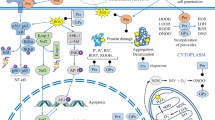Abstract
Ascorbic acid (AH2) is a potential scavenger of superoxide radical and singlet oxygen. In the guinea pig, marginal AH2 deficiency results in intracellular oxidative damage in the cardiac tissue as evidenced by lipid peroxidation, formation of fluorescent pigment and loss of structural integrity of the microsomal membranes. The oxidative damage does not occur due to lack of enzymatic scavengers of reactive oxygen species such as superoxide dismutase, catalase and glutathione peroxidase. Also, glutathione transferase activity is not decreased in AH2 deficiency. Lipid peroxidation, fluorescent pigment formation and protein modification disappear after AH2 therapy. These results, if extra-polated to human beings, would indicate that chronic subclinical AH2 deficiency may result in progressive oxidative damage which in the long run may lead to permanent degenerative diseases in the heart.
Similar content being viewed by others
References
Clemetson CAB: Vitamin C, Vol. III CRC Press Inc., Boca Raton, Florida, 1989, pp 247–256
Som S, Raha C, Chatterjee IB: Ascorbic acid: a Scavenger of Superoxide radical. Acta Vitaminol Enzymol 5: 243–250, 1983
Nandi A, Chatterjee IB: Scavenging of Superoxide radical by ascorbic acid. J Biosci 11: 435–441, 1987
Nishikimi M: Oxidation of ascorbic acid with superoxide anion generated by the xanthine — xanthine oxidase system. Biochem Biophys Res Commun 63: 463–468, 1975
Allen JF, Hall DO: Superoxide reduction as a mechanism of ascorbate stimulated oxygen uptake by isolated chloroplasts. Biochem Biophys Res Commun 52: 856–862, 1973
Bodannes RS, Chen PC: Ascorbic acid quenches singlet oxygen rapidly. FEBS Lett 105: 195–196, 1979
Fridovich I: Superoxide dismutases. Adv Enzymol 41: 35–97, 1974
Martonosi A: Sarcoplasmic reticulum IV. Solubilization of microsomal adenosine triphosphate. J Biol Chem 243: 71–81, 1968
Buege JA, Aust SD: Microsomal lipid peroxidation. Methods Enzymol 105: 302–310, 1984
Itch F, Horie T, Awazu S: Fluorescence emitted from microsomal membranes by lipid peroxidation. Arch Biochem Biophys 264: 184–191, 1988
Ginter E: Ascorbic acid in cholesterol and bile acid metabolism. Ann NY Acad Sci 258: 410–421, 1975
Chatterjee IB, Banerjee A: Estimation of dehydro-ascorbic acid in blood of diabetic patients. Anal Biochem 98: 368–374, 1979
Lowry OH, Rosebrough NJ, Farr AL, Randall RJ: Protein measurement with the Folin phenol reagent. J Biol Chem 193: 265–275, 1951
Laemmli UK: Cleavage of structural proteins during the assembly of the head of bacteriophage Tr. Nature 227: 680–685, 1970
Akerboom TPM, Sies H: Assay of glutathione, glutathione disulfide and glutathione mixed disulfides in biological samples. Methods Enzymol 77: 373–382, 1981
Nandi A, Chatterjee IB: Assay of superoxide dismutase activity in animal tissues. J Biosci 13: 305–315, 1988
Aebi H: Catalase in vitro. Methods Enzymol 105: 121–126, 1984
Fiché L, Günzler WA: Assay of glutathione peroxidase. Methods Enzymol 105: 114–121, 1984
Mannervik B, Guthenberg C: Glutathione transferase (human placenta). Methods Enzymol 77: 231–235, 1981
Koster JF, Slee RG: Lipid peroxidation of rat liver microsomes. Biochim Biophys Acta 620: 489–499, 1980
Tappel AL: Lipid peroxidation damage to cell components. Fed Proc 32: 1870–1874, 1973
Trotta RJ, Sullivan SG, Stern A: Lipid peroxidation and haemoglobin degradation in red blood cells exposed to t-butyl hydroperoxide. Biochem J 204: 405–415, 1982
Frei B, England L, Ames BN: Ascorbate is an outstanding antioxidant in human blood plasma. Proc Natl Acad Sci USA 86: 6377–6381, 1989
Shafar J: Rapid reversion of electrocardiographic abnormalities after treatment in two cases of scurvy. Lancet 2: 176, 1967
Sament S: Cardiac disorder in scurvy. N Engl J Med 282: 282, 1970
Willis GC: An experimental study of the intimal ground substance in atherosclerosis. Can Med Assoc J 69: 17, 1953
Singal PK, Kapur N, Dhillon KS, Beamish RE, Dhalla NS: Role of free radical in catecholamine-induced cardiomyopathy. Can J Physiol Pharmacol 60: 1390–1397, 1982
Kibata M, Higuchi Y: Serum α-tocopherol, coenzyme Q and thiobarbituric acid—reactive substance in acute myocardial damage and stroke. Ann NY Acad Sci 393: 179–182, 1982
Kudrin AN, Kogan AJ, Koroljiv UV, Nyikolajev SzM, Beszkrovnova NN: The role of lipid peroxidation in the pathogenesis of myocardial infarction and favourable effect of antioxidants sodium selenite and vitamin E. Kardiologia 18: 115, 1978
Author information
Authors and Affiliations
Rights and permissions
About this article
Cite this article
Chakrabarty, S., Nandi, A., Mukhopadhyay, C.K. et al. Protective role of ascorbic acid against lipid peroxidation and myocardial injury. Mol Cell Biochem 111, 41–47 (1992). https://doi.org/10.1007/BF00229572
Issue Date:
DOI: https://doi.org/10.1007/BF00229572




